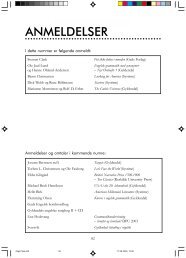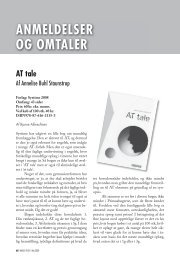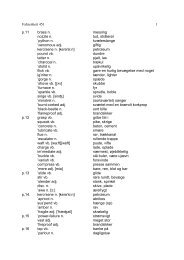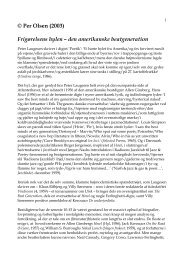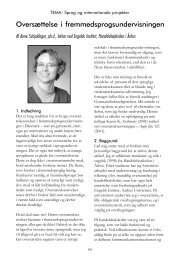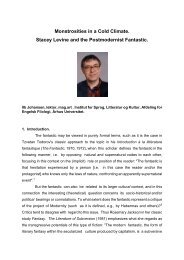REDAKTIONELT - Anglo Files
REDAKTIONELT - Anglo Files
REDAKTIONELT - Anglo Files
You also want an ePaper? Increase the reach of your titles
YUMPU automatically turns print PDFs into web optimized ePapers that Google loves.
18 19<br />
The twentieth anniversary of the<br />
proclamation of a policy of<br />
multiculturalism for Canada is<br />
less than two years away. At<br />
least one person is planning to<br />
observe the occasion: he intends<br />
to publish a book, tentatively<br />
entitled "Multiculturalism: The<br />
Other Side," devoted to arguments<br />
against multiculturalism. He<br />
telephoned the Multicultural<br />
History Society of Ontario to<br />
complain that he had found only<br />
one article against multiculturalism<br />
and to ask for assistance<br />
in locating more. He was given<br />
a list of ten or a dozen works.<br />
In its second decade multiculturalism<br />
has advanced far beyond<br />
what was anticipated in 1971, but<br />
it has by no means won general<br />
acceptance.<br />
Multiculturalism "can be defined<br />
as the official recognition by<br />
governments, expressed in legislation<br />
and/or in speeches and<br />
programs, of the many different<br />
origins of their present populations,<br />
combined with the stated<br />
intention to protect and assist<br />
those who are not members of the<br />
founding majority or charter<br />
groups." (1) In Canada it is one<br />
of a bundle of policies, including<br />
those concerning immigration,<br />
citizenship and human rights. The<br />
aim of the policies is to make<br />
Canada open to all on the same<br />
terms and to facilitate full and<br />
equal participation in society by<br />
all, whatever their race, ethnic<br />
origin, colour or culture. To<br />
that end it is considered laudable<br />
for all to retain cherished<br />
symbols of their cultural and<br />
linguistic heritages, and assistance<br />
is made available for such<br />
retention. Although the policies<br />
are not administered by a single<br />
department, they are similar in<br />
MULTICULTURALISM: THE SECOND DECADE<br />
af Dr. Jean Burnet,<br />
The Multicultural History Society of Ontario, Toronto<br />
aim and cannot be discussed in<br />
complete isolation from one<br />
another.<br />
Multiculturalism might seem to<br />
be a natural and inevitable<br />
policy for Canada. Its population<br />
was heterogeneous even before<br />
European contact, as the name the<br />
descendants of its earliest<br />
peoples have chosen for<br />
themselves implies: not the First<br />
Nation but the First Nations.<br />
There were at least fifty<br />
societies with at least a dozen<br />
languages when Europeans began<br />
to explore and settle the<br />
northern half of North America.<br />
The heterogeneity of the popution<br />
has increased with time,<br />
slowly during the French regime,<br />
more quickly under the British,<br />
and very quickly during the last<br />
century, with the opening of the<br />
West in early decades and the<br />
massive immigration and flow of<br />
refugees after World War II. Now<br />
the Canadian population is drawn<br />
from all parts of the world, and<br />
every region in the country has<br />
a characteristic ethnic mixture.<br />
The groups forming those mixtures<br />
frequently try to trace their<br />
Canadian roots to explorers or<br />
pioneers whose association with<br />
the particular groups claiming<br />
them is extremely tenuous.<br />
Similarly multiculturalism is<br />
sometimes given a lineage as<br />
lengthy as it is dubious. Canadians<br />
talk of traditions of ethnic<br />
and racial tolerance that differentiate<br />
them from their usual<br />
standard of comparison, the<br />
Americans. They are, however,<br />
more like the Americans than they<br />
like to admit. They have a heritage<br />
of slavery of both Africans<br />
and Amerindians. If it was more<br />
benign, on a smaller scale and of<br />
shorter` duration than American<br />
slavery, it was so because of<br />
economic and geographical conditions<br />
rather than moral superiority.<br />
Canadians have a long<br />
history of - broken promises to the<br />
First Nations, for which they are<br />
now being called to account, and<br />
of discrimination against African<br />
Canadians. Anti-Semitism goes<br />
back to the French regime, when<br />
Jews, along with other non-Roman<br />
Catholics; were rigorously<br />
excluded from the colony. If Jews<br />
were admitted under the British<br />
and in 1$32 achieved full rights<br />
of citizenship, they have<br />
frequently endured discrimination<br />
both at the gates to the country<br />
and inside it: Abella and<br />
Troper's "None Is Too Many (2)<br />
presents examples from the 1930s<br />
and 1940s that are all too<br />
graphic. ':Chinese, Japanese and<br />
South Asians - "hindoos" - met<br />
little tolerance. Pacifist sects<br />
such as the Doukhobors, Mennonites<br />
and Hutterites owed their<br />
admittance to their reputation<br />
as farmes, but that was not<br />
enough to win them acceptance<br />
from their neighbours; neither,<br />
by the way, were the British and<br />
Scandinavian ethnic origins and<br />
American experience of the<br />
Mormons. The people from central<br />
and eastern Europe - the stalwart<br />
peasants in sheepskin coats,<br />
their stout wives and numerous<br />
children who were considered the<br />
best settlers for the second-best<br />
land by the framer of Canada's<br />
first energetic immigration<br />
campaign, Clifford Sifton -<br />
encountered such epithets as<br />
white niggers.<br />
Discrimination was not only informal:<br />
it was built into federal<br />
and provincial laws and regulations<br />
and local by-laws. Much of<br />
it was direct and open. The requirement<br />
of 1908 that immigrants<br />
had to come on a continuous journey<br />
from their country of origin<br />
was a veiled attack on South<br />
Asians and Japanese - it was also<br />
used against Jews - but there was<br />
nothing covert about the Chinese<br />
Immigration (Exclusion) Act of<br />
1923. Restrictive covenants on<br />
residential areas were often<br />
frank in barring Jews and<br />
Negroes, though sometimes summer<br />
resorts genteelly spoke of select<br />
clienteles. As late as the 1940s<br />
a federal cabinet minister could<br />
assert in the House of Commons<br />
that Canada was for the white<br />
race, and Prime Minister<br />
Mackenzie King could opine that<br />
Canadians did not want to make<br />
a fundamental change in the<br />
character of the population by<br />
"large-scale immigration from the<br />
Orient." (3) <strong>Anglo</strong>-conformity was<br />
the aim of policy, and the discriminations<br />
against non-British<br />
and non-Europeans were coupled<br />
with discriminations in favour<br />
of British subjects. By the 1930s<br />
the mosaic had become a staple<br />
of political speeches, but it is<br />
difficult to find concrete<br />
measures that encouraged the<br />
maintenance of differences rather<br />
than assimilation.<br />
The mosaic was contrasted with<br />
the American melting pot, and<br />
there was a strong conviction<br />
that the British dealt with<br />
racial and ethnic relations<br />
better than the Americans. The<br />
British tradition, not discriminatory<br />
immigration regulations,<br />
was credited with the lack of<br />
colour problems in Canada and<br />
with the scarcity of immigrant<br />
ghettoes in Canadian cities. Now,<br />
when England has received many<br />
coloured people from its former<br />
colonies and has responded to<br />
them with prejudice and discrimination<br />
as vicious as that in the<br />
United States, it is hard to<br />
remember that the British used<br />
to claim superiority in dealing<br />
with race and ethnic situations<br />
and harder still to remember how<br />
they explained it.<br />
When Mackenzie King made his pronouncement<br />
in 1947 the Canadian<br />
population was still basically<br />
British: outside of Quebec 60




